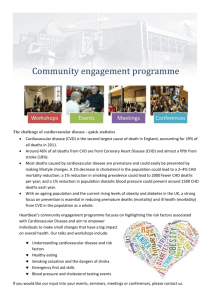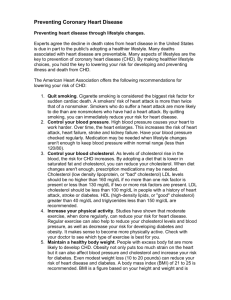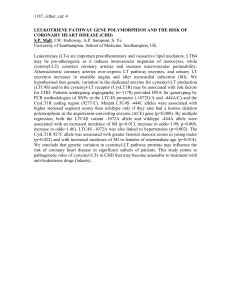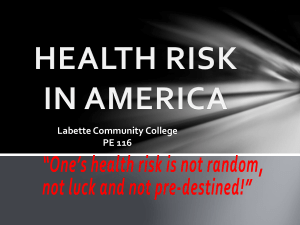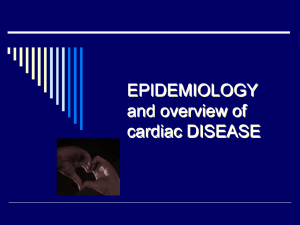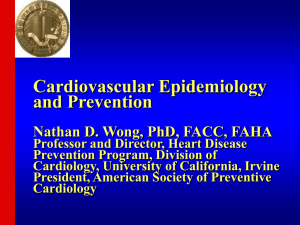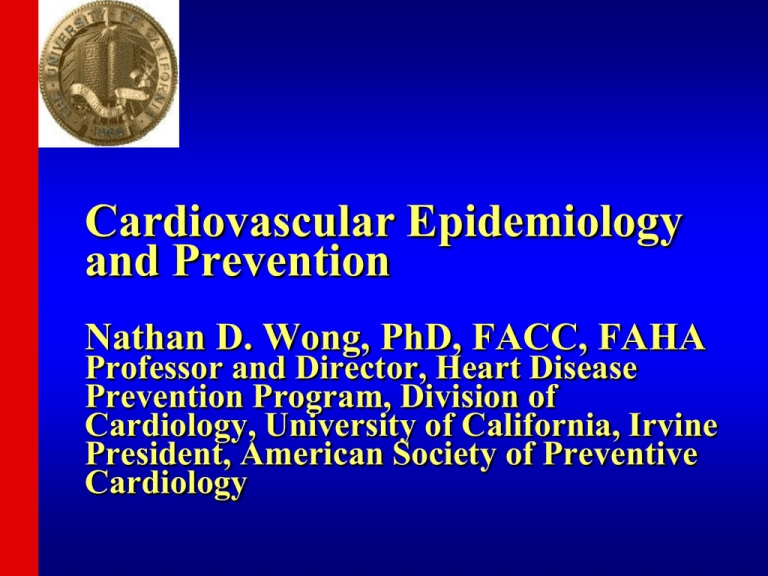
Cardiovascular Epidemiology
and Prevention
Nathan D. Wong, PhD, FACC, FAHA
Professor and Director, Heart Disease
Prevention Program, Division of
Cardiology, University of California, Irvine
President, American Society of Preventive
Cardiology
Textbooks
Cardiovascular Epidemiology:
Definitions, Concepts,
Historical Perspectives and
Statistics
Definitions
• CORONARY ARTERY DISEASE (CAD) or
CORONARY HEART DISEASE (CHD)
(often broadly referred to as ISCHEMIC
HEART DISEASE (IHD): primarily
myocardial infarction and sudden
coronary death, broader definition may
include angina pectoris, atherosclerosis,
positive angiogram, and revascularization
(perceutaneous coronary interventions, or
PCI such as angioplasty and stents)
• CARDIOVASCULAR DISEASE or CVD
includes CHD, cerebrovascular disease,
peripheral vascular disease, and other
cardiac conditions (congenital,
arrhythmias, and congestive heart failure)
Definitions (cont.)
• SURROGATE MEASURES include: carotid
intimal medial thickness (IMT), coronary
calcium, angiographic stenosis, brachial
ultrasound flow mediated dilatation (FMD)
• Hard endpoints include myocardial
infarction, CHD death, and stroke
CVD and other major causes of death for all males and females
(United States: 2007).
450,000
421,918
400,000
391,886
350,000
292,857
300,000
Deaths
270,018
250,000
200,000
150,000
79,827
66,689
100,000
61,235
52,832
43,879
35,478
50,000
35,904
21,800
0
A
B
C
D
E
Males
F
A
B
D
F
C
E
Females
Source: NCHS and NHLBI. A indicates CVD plus congenital CVD; B, cancer; C, accidents; D, CLRD; E, diabetes; and F, Alzheimer's disease.
©2010 American Heart Association, Inc. All rights reserved.
Roger VL et al. Published online in Circulation Dec. 15, 2010
Trends in cardiovascular procedures, United States: 1979–2009
1400
Procedures in Thousands
1200
1000
800
600
400
200
0
1979
1980
1985
1990
1995
2000
2005
2009
Years
Catheterizations
Bypass
PCI
Carotid Endarterectomy
Pacemakers
Note: Inpatient procedures only. Source: National Hospital Discharge Survey, NCHS, and NHLBI.
©2011 American Heart Association, Inc. All rights reserved.
Roger VL et al. Published online in Circulation Dec. 15, 2011
Direct and indirect costs (in billions of dollars)
of major cardiovascular diseases and stroke (United States: 2008)
200
190.3
180
160
Billions of Dollars
140
120
100
80
60
50.6
40
34.3
22.5
20
0
Heart disease
Hypertension
Stroke
Other CVD
Source: National Heart, Lung, and Blood Institute.
©2011 American Heart Association, Inc. All rights reserved.
Roger VL et al. Published online in Circulation Dec. 15, 2011
Projected Total Costs of CVD, 2015–2030 (in Billions 2008$) in the United States
1200
1117.6
Total Dollars (in Billions)
1000
800
886.2
704.7
564.9
600
408.5
400
245.2
194.1
121.1
250.5
186.7
153.2
200
320.0
223.8
143.0
97.0
156.9
132.4
111.2
87.1
74.1
44.6
57.0
197.8
69.1
0
All CVD
Hypertension
CHD
2015
2020
HF
2025
Stroke
Other CVDs
2030
Unpublished data tabulated by AHA using methods described in Circulation. 2011;123:933–944.
©2011 American Heart Association, Inc. All rights reserved.
Roger VL et al. Published online in Circulation Dec. 15, 2011
Deaths in Thousands
550
500
450
400
350
79
80
85
90
95
Years
Males
Females
00
06
Discharges in Millions
7
6
5
4
3
2
1
0
70
75
80
85
90
95
00
06
Years
Hospital discharges for cardiovascular diseases.
(United States: 1970-2006). Note: Hospital discharges include
people discharged alive, dead and status unknown.
Source: NCHS and NHLBI.
Prevalence of CVD in adults ≥20 years of age by age and sex (NHANES: 2005–2008)
100
90
86.7
80.1
80
72.6
71.9
Percent of Population
70
60
50
39.3
40
37.2
30
20
10
14.2
9.7
0
20-39
40-59
60-79
Men
80+
Women
Source: NCHS and NHLBI. These data include CHD, HF, stroke, and hypertension.
©2011 American Heart Association, Inc. All rights reserved.
Roger VL et al. Published online in Circulation Dec. 15, 2011
Deaths due to diseases of the heart (United States: 1900–2008)
Deaths in Thousands
1,000
800
600
400
200
Years
0
1900
1910
1920
1930
1940
1950
1960
1970
1980
1990
2000
2008
Source: National Center for Health Statistics.
©2011 American Heart Association, Inc. All rights reserved.
Roger VL et al. Published online in Circulation Dec. 15, 2011
Deaths in Thousands
1,000
831
800
560
600
315
400
242
200
25 21
48 50
165
120 138
81 101
85
0
<45
45-54
55-64
65-74
75-84
Ages
CVD
Cancer
CVD deaths vs. cancer deaths by age.
(United States: 2006). Source: NCHS.
85+
Total
CVD and other major causes of death for all males and females (United States: 2008)
450,000
419,730
400,000
392,210
350,000
295,259
300,000
Deaths
270,210
250,000
200,000
150,000
78,378
100,000
73,968
67,122
57,919
43,524
35,346
50,000
35,207
24,516
0
A
B
C
D
E
Males
F
A
B
D
F
C
E
Females
Source: NCHS and NHLBI. A indicates CVD plus congenital CVD; B, cancer; C, accidents; D, CLRD; E, diabetes; and F, Alzheimer's disease.
©2011 American Heart Association, Inc. All rights reserved.
Roger VL et al. Published online in Circulation Dec. 15, 2011
Prevalence of stroke by age and sex (NHANES: 2005–2008)
18
16
14.8
14.5
Percent of Population
14
12
10
8.2
8
7.2
6
4
2.4
1.6
2
0.3
0.5
0
20-39
40-59
Age
Men
60-79
80+
Women
Source: NCHS and NHLBI.
©2011 American Heart Association, Inc. All rights reserved.
Roger VL et al. Published online in Circulation Dec. 15, 2011
Prevalence of stroke by age and sex (NHANES: 2005–2008).
18
16
14.5
14.8
Percent of Population
14
12
10
8.2
8
7.2
6
4
2.4
1.6
2
0.3
0.5
0
20-39
40-59
Men
Age
60-79
80+
Women
Source: NCHS and NHLBI.
©2010 American Heart Association, Inc. All rights reserved.
Roger VL et al. Published online in Circulation Dec. 15, 2010
Coronary Heart
Disease
Stroke
14
7
4
HF*
51
7
17
High Blood Pressure
Diseases of the
Arteries
Other
Percentage breakdown of deaths from cardiovascular diseases
(United States: 2006) * - Not a true underlying cause.
Source: NCHS.
Percent of Population
16
14
12
10
8
6
4
2
0
13.8
12.2
9.3
4.8
2.2
0.1 0.2
20-39
1.2
40-59
Men
60-79
Women
Prevalence of heart failure by age and sex
(NHANES: 2005-2006). Source: NCHS and NHLBI.
80+
Discharges in Thousands
700
600
500
400
300
200
100
0
79
80
85
90
95
00
06
Years
Male
Female
Hospital discharges for heart failure by sex.
(United States: 1979-2006). Source: NHDS/NCHS and NHLBI.
Note: Hospital discharges include people discharged alive, dead
and status unknown.
Development of Atherosclerotic
Plaques
Fatty streak
Normal
Lipid-rich plaque
Foam cells
Fibrous cap
Thrombus
Ross R. Nature. 1993;362:801-809.
Lipid core
PDAY: Percentage of Right Coronary Artery
Intimal Surface Affected With Early Atherosclerosis
30
Intimal
surface
(%)
Men
Raised lesions 30
Fatty streaks
20
20
10
10
0
30
0
15-19 20-24 25-29 30-34
White
30
20
20
10
10
0
0
15-19 20-24 25-29 30-34
Black
Age (y)
PDAY= Pathobiological Determinants of Atherosclerosis in Youth.
Strong JP, et al. JAMA. 1999;281:727-735.
Women
15-19 20-24 25-29 30-34
White
15-1920-2425-2930-34
Black
Most Myocardial Infarctions Are Caused
by Low-Grade Stenoses
Pooled data from 4 studies: Ambrose et al, 1988; Little et al, 1988; Nobuyoshi et al, 1991; and Giroud et al,
1992.
(Adapted from Falk et al.)
Falk E et al, Circulation, 1995.
Coronary Remodeling
Progression
Compensatory expansion
maintains constant lumen
Normal
vessel
(Adapted from Glagov et al.)
Glagov et al, N Engl J Med, 1987.
Minimal
CAD
Moderate
CAD
Expansion
overcome:
lumen narrows
Severe
CAD
Atherosclerotic Plaque Rupture and
Thrombus Formation
Intraluminal thrombus
Growth of thrombus
Blood Flow
Intraplaque thrombus
Adapted from Weissberg PL. Eur Heart J Supplements
1999:1:T13–18
Lipid pool
Features of a Ruptured
Atherosclerotic Plaque
• Eccentric, lipid-rich
• Fragile fibrous cap
• Prior luminal
obstruction < 50%
• Visible rupture
and thrombus
Constantinides P. Am J Cardiol. 1990;66:37G-40G.
Vulnerable Versus Stable
Atherosclerotic Plaques
Vulnerable Plaque
Lumen
Fibrous Cap
Lipid
Core
• Thin fibrous cap
• Inflammatory cell infiltrates:
proteolytic activity
• Lipid-rich plaque
Stable Plaque
Lumen
Lipid
Core
Fibrous Cap
Libby P. Circulation. 1995;91:2844-2850.
• Thick fibrous cap
• Smooth muscle cells:
more extracellular matrix
• Lipid-poor plaque
Correlation of CT angiography of the
coronary arteries with intravascular
ultrasound illustrates the ability of MDCT
to demonstrate calcified and non-calcified
coronary plaques (Becker et al., Eur J
Radiol 2000)
Non-calcified, soft, lipid-rich plaque in
left anterior descending artery (arrow)
(Somatom Sensation 4, 120 ml Imeron
400). The plaque was confirmed by
intravascular ultrasound (Kopp et al.,
Radiology 2004)
Concept of cardiovascular
“risk factors”
Age, sex, hypertension, hyperlipidemia, smoking, diabetes,
(family history), (obesity)
Kannel et al, Ann Intern Med 1961
Major Risk Factors
• Cigarette smoking (passive smoking?)
• Elevated total or LDL-cholesterol
• Hypertension (BP 140/90 mmHg or on
antihypertensive medication)
• Low HDL cholesterol (<40 mg/dL)†
• Family history of premature CHD
– CHD in male first degree relative <55
years
– CHD in female first degree relative <65
years
• Age (men 45 years; women 55 years)
†
HDL cholesterol 60 mg/dL counts as a “negative” risk factor; its
presence removes one risk factor from the total count.
Other Recognized Risk
Factors
• Obesity: Body Mass Index (BMI)
– Weight (kg)/height (m2)
– Weight (lb)/height (in2) x 703
• Obesity BMI >30 kg/m2 with overweight
defined as 25-<30 kg/m 2
• Abdominal obesity involves waist
circumference >40 in. in men, >35 in. in
women
• Physical inactivity: most experts
recommend at least 30 minutes moderate
activity at least 4-5 days/week
Prevalence (unadjusted) estimates for poor, intermediate and ideal cardiovascular health
for each of the 7 metrics of cardiovascular health in the AHA 2020 goals,
US children aged 12-19 years, NHANES 2007-2008
©2011 American Heart Association, Inc. All rights reserved.
Roger VL et al. Published online in Circulation Dec. 15, 2011
Age-standardized prevalence for poor, intermediate and ideal cardiovascular health for each
of the 7 metrics of cardiovascular health in the AHA 2020 goals,
among US adults >20 years of age, NHANES 2007-2008
©2011 American Heart Association, Inc. All rights reserved.
Roger VL et al. Published online in Circulation Dec. 15, 2011
____________________________________________________________
Lifetime Risk of Coronary Heart Disease
in the Framingham Study
______________________________________________________________
Men
At age 40 years: 48.6%
At age 70 years: 34.9%
Women
31.7%
24.2%
_________________________________________________________________
Lloyd-Jones et al. Lancet 1999; 353:89-92
____________________________________________________________
First Coronary Events: Framingham
Study
________________________________________________________
Percent as Specified Event
Myocardial
Infarction
Age Men Women
Angina
Pectoris
Men Women
35-64 43% 28%
65-84 55% 44%
41%
28%
59%
41%
Sudden
Death
Men Women
9%
4%
11% 7.4%
____________________________________________________________
Framingham Study 44 year follow-up.
Estimated 10-Year CHD Risk in
55-Year-Old Adults According to Levels
of Various Risk Factors
Estimated 10-Year Rate (%)
Framingham Heart Study
40
35
30
25
20
15
10
5
0
37
27
25
20
Men
Women
13
5
8
5
A
B
C
A
B
D
C
D
Blood Pressure (mm Hg)
120/80
140/90
140/90
140/90
Total Cholesterol (mg/dL)
200
240
240
240
HDL Cholesterol (mg/dL)
50
50
40
40
Diabetes
No
No
Yes
Yes
Cigarettes
No
No
No
Yes
mm Hg = millimeters of mercury
mg/dL = milligrams per deciliter of blood
Source: Circulation 1998;97:1837-1847.
Estimated 10-Year Stroke Risk in 55Year-Old Adults According to Levels of
Various Risk Factors
Estimated 10-Year Rate (%)
Framingham Heart Study
30
27
25
22.4
19.1
20
14.8
15
8.4
10
5
2.6
6.3
5.4
4
3.5
2
1.1
0
A
B
C
D
Men
Systolic BP*
Diabetes
Cigarettes
Prior Atrial Fib.
Prior CVD
A
95-105
No
No
No
No
B
130-148
No
No
No
No
Source: Stroke 1991;22:312-318.
E
F
Women
C
130-148
Yes
No
No
No
D
130-148
Yes
Yes
No
No
E
130-148
Yes
Yes
Yes
No
F
130-148
Yes
Yes
Yes
Yes
*BP in millimeters of mercury (mmHg)
Offspring CVD Risk by Parental CVD Status:
Framingham Study
Parental CVD <55
men, <65 Women
NONE
MATERNAL
PATERNAL
Risk Ratio
2.5
2.5
22
2.2
1.5
1.7
1.7
1.7
11
1.0
1.0
0.5
0.5
00
Men
MEN
Women
WOMEN
Adjusted for: age, total/HDL Chol. ratio, SBP, smoking, diabetes, BMI
Risk imposed by a strong family
history of heart attacks varies widely
depending on the burden of
modifiable risk factors
Multivariable Risk
9
Doubts about
cholesterol as
late as 1989
_______________________________________________________________________________
Lifetime Risk of CHD Increases with Serum
Cholesterol
___________________________________________________________________________
60
50
Cholesterol
<200 mg
200-239 mg
57
>240 mg
Percent
40
44
30
34
29
20
33
19
10
0
Men
Women
Framingham Study: Subjects age 40 years
DM Lloyd-Jones et al Arch Intern Med 2003; 1966-1972
Correlation Between Serum
Cholesterol and CVD Mortality
6-Year CVD Death Rate Per 1000
30
Multiple Risk Factor Intervention Trial (MRFIT)
N=325,346
Untreated Patients
25
55-57 years
20
50-54 years
15
45-49 years
10
40-44 years
35-39 years
5
0
Q1
(<182)
Q2
(182-202)
Q3
(203-220)
Q4
(221-244)
Q5
(>244)
Serum Cholesterol Quintile (mg/dL)
Q = serum cholesterol quintile.
Kannel WB et al. Am Heart J. 1986;112:825-836.
Trends in mean total serum cholesterol among adolescents 12–17 years of
age by race, sex, and survey year (NHANES: 1988–1994*, 1999–2004 and
2005-2008).
180
174
Mean Total Blood Cholesterol
175
170
166
165
165
161
160
163
163
163
162
161
160
158
159
158
157
155
155
154
150
145
140
NH White Males
NH Black Males
1988-94
NH White
Females
NH Black Females Mex. Am. Males Mex. Am. Females
1999-2004
2005-2008
Source: NCHS and NHLBI. NH indicates non-Hispanic. Mex. Am. indicates Mexican American.
* Data for Mexican Americans not available.
©2010 American Heart Association, Inc. All rights reserved.
Roger VL et al. Published online in Circulation Dec. 15, 2010
Trends in mean total serum cholesterol among adults ages ≥20
by race and survey year,
(NHANES: 1988–1994, 1999–2004 and 2005–2008).
210
206
205
Mean Serum Total Cholesterol
205
204
203
201
201
200
198
198
195
192
190
185
180
NH White
NH Black
1988-94
1999-2004
Mexican American
2005-2008
Source: NCHS and NHLBI. NH indicates non-Hispanic.
©2010 American Heart Association, Inc. All rights reserved.
Roger VL et al. Published online in Circulation Dec. 15, 2010
________________________________________________________
CK Friedberg on Hypertension:
Diseases of the Heart 1996
___________________________________________________________
“There is a lack of correlation in
most cases between the severity
and duration of hypertension and
development of cardiac
complications.”
_______________________________________________________________
Relation of Non-Hypertensive Blood
Pressure to Cardiovascular Disease
Vasan R, et al. N Engl J Med 2001; 345:1291-1297
10-year Age- Adjusted Cumulative Incidence
12%
Hazard Ratio*
<120/80 mm Hg
120-129/80-84 mm Hg
130-139/85-89 mm Hg
10%
SBP
10.1
8%
7.6
6%
2%
4.4
2.8
1.9
0%
Women
1.0
1.5
2.5
1.0
1.3
1.6
H.R. adjusted for age,
BMI, Cholesterol, Diabetes
and smoking *P<.001
5.8
4%
<120/80
120-129
130-139
Women Men
Men
Framingham Study: Subjects Ages 35-90 yrs.
Prevalence of High Blood Pressure in adults ≥20 years of age
by age and sex (NHANES: 2005–2008)
90
78.5
80
69.3
70
Percent of Population
64.0
60
54.0
66.7
53.3
50
37.1
40
30
35.2
25.1
19.0
20
11.1
10
6.8
0
20-34
35-44
45-54
55-64
65-74
75+
Age
Male
Female
Source: NCHS and NHLBI. Hypertension is defined as SBP 140 mm Hg or DBP 90 mmHg, taking antihypertensive medication, or being told twice by a
physician or other professional that one has hypertension.
©2011 American Heart Association, Inc. All rights reserved.
Roger VL et al. Published online in Circulation Dec. 15, 2011
Percent of Population With
Hypertension
90
80
70
60
50
40
30
20
10
0
78.8 79.0
82.3
67.6
74.7
69.1 70.1
52.1
46.5
45.4 46.1
35.2
Awareness
Total Population
NH Whites
Treatment
NH Blacks
Controlled
Mexican Americans
Extent of awareness, treatment and control of high blood pressure
by race/ethnicity (NHANES : 2005-2006).
Source: NCHS and NHLBI.
_______________________________________________________________
CK
Friedberg
on
Hypertension
_______________________________________________________________
Diseases of the Heart 1966
“Hypertension imposes a load on
the heart which for many years
may be compensated by left
ventricular hypertrophy”
_______________________________________________________________
CVD Risk Imposed by ECG-LVH
Framingham Study 36-yr. Follow-up
_______________________________________________________________
Age-adjusted
Rate per 1000
Age Men Women
35-64 164
135
65-94 234
235
Risk
Excess Risk
Ratio
per 1000
Men Women Men Women
4.7*** 7.4***
129
117
2.8*** 4.1*** 51
178
_____________________________________________________________
Biennial Rate per 1000. CVD=CHD, stroke,
peripheral vascular disease, heart failure
***P<0.001
____________________________________________________________
Smoking Statement Issued in 1956 by
American Heart Association
___________________________________________________________
“It is the belief of the committee that much
greater knowledge is needed before any
conclusions can be drawn concerning
relationships between smoking and
death rates from coronary heart
disease. The acquisition of such
knowledge may well require the use of
techniques and research methods that
have not hitherto been applied to this
___________________________________________________________
problem.”
CHD Risk by Cigarette Smoking. Filter
Vs. Non-filter. Framingham Study. Men
<55 Yrs.
14-yr. Rate/1000
250
Non-Smoker
Reg. Cig. Smoker
Filter Cig. Smoker
200
206
210
150
100
210
119
112
50
59
0
Total CHD
Myocardial
Infarction
Prevalence of students in grades 9 to 12 reporting current cigarette use
by sex and race/ethnicity (YRBSS, 2009)
25
22.3
22.8
19.4
Percent of the Population
20
16.7
15
10.7
10
8.4
5
0
NH White
NH Black
Males
Hispanic
Females
Source: MMWR Surveill Summ. 2010;59:1–142.NH indicates non-Hispanic.
©2011 American Heart Association, Inc. All rights reserved.
Roger VL et al. Published online in Circulation Dec. 15, 2011
Prevalence of current smoking for adults > 18 years of age
by race/ethnicity and sex (NHIS: 2007-2009)
30
26.8
25
Percent of Population
22.9
23.6
19.9
20
18.9
17.9
17.0
15.4
15
9.3
10
5.4
5
0
Men
NH White
NH Black
Women
Hispanic
Asian*
American Indian/Alaska Native*
All percentages are age-adjusted. NH indicates non-Hispanic. *Includes both Hispanics and non-Hispanics. Data derived from Centers for Disease Control
and Prevention/National Center for Health Statistics, Health Data Interactive.
©2011 American Heart Association, Inc. All rights reserved.
Roger VL et al. Published online in Circulation Dec. 15, 2011
Prevalence of current smoking for adults > 18 years of age
by race/ethnicity and sex (NHIS: 2006-2008)
35
30.2
30
Percent of Population
25
24.0
25.0
22.1
21.0
20
18.4
17.1
15.7
15
9.4
10
4.5
5
0
Men
NH White
NH Black
Women
Hispanic
Asian*
American Indian/Alaska Native*
Source: CDC/NCHS, Health Data Interactive. All percentages are age-adjusted. NH indicates non-Hispanic.
* Includes both Hispanics and non-Hispanics.
©2010 American Heart Association, Inc. All rights reserved.
Roger VL et al. Published online in Circulation Dec. 15, 2010
Diseases of The Heart
Charles K Friedberg MD, WB
________________________________________________________________
Saunders Co. Philadelphia, 1949
“The proper control of diabetes is
obviously desirable even though
there is uncertainty as to whether
coronary atherosclerosis is more
frequent or severe in the
uncontrolled diabetic”
______________________________________________________________
Risk of Cardiovascular Events in Diabetics
Framingham Study
_________________________________________________________________
Cardiovascular Event
Coronary Disease
Stroke
Peripheral Artery Dis.
Cardiac Failure
All CVD Events
Age-adjusted
Biennial Rate Age-adjusted
Per 1000
Risk Ratio
Men Women Men Women
39 21
1.5** 2.2***
15
6
2.9*** 2.6***
18 18
3.4*** 6.4***
23 21
4.4*** 7.8***
76 65
2.2*** 3.7***
_________________________________________________________________
Subjects 35-64 36-year Follow-up **P<.001,***P<.0001
Age-adjusted prevalence of physician-diagnosed diabetes in
adults ≥20 years of age
by race/ethnicity and sex (NHANES: 2005–2008).
16
14.7
14.3
14
12.7
12
Percent of Population
11.0
10
8
6.8
6.5
6
4
2
0
Male
NH White
Female
NH Black
Mexican American
Source: NCHS and NHLBI. NH indicates non-Hispanic.
©2010 American Heart Association, Inc. All rights reserved.
Roger VL et al. Published online in Circulation Dec. 15, 2010
Trends in diabetes prevalence in adults ≥20 years of age, by
sex
(NHANES: 1988–1994 and 2005–2008).
9
8.2
7.9
8
Percent of Population
7
6
5.4
5.4
5
4.1
4
3.4
3
2.5
2.3
2
1
0
Physician Diagnosed 1988-94
Undiagnosed 1988-94
Male
Physician Diagnosed 2005-08
Undiagnosed 2005-08
Female
Source: NCHS, NHLBI.
©2010 American Heart Association, Inc. All rights reserved.
Roger VL et al. Published online in Circulation Dec. 15, 2010
Skepticism About Importance of Obesity
Keys A, Aravanis C, Blackburn H, et al. Ann Intern Med 1972;
77:15-27.
Concluded that all the excess risk of coronary heart
disease in the obese derives from its atherogenic
accompaniments, illogically leaving the impression that obesity
is therefore unimportant.
Mann GV. N Engl J Med 1974; 291:226-232.
“The contribution of obesity to CHD is either small or
non-existent. It cannot be expected that treating obesity is
either logical or a promising approach to the management of
CHD”.
Barrett-Connor EL. Ann Intern Med 1985; 103:1010-1019
NIH consensus panel is equivocal about the role of
obesity as a cause of CHD.
Relation of Weight Change to Changes in
Atherogenic Traits: The Framingham Study
Frantz Ashley, Jr. and William B Kannel
J Chronic Dis 1974
“Weight gain is accompanied by atherogenic alterations in
blood lipids, blood pressure, uric acid and carbohydrate
tolerance.”
“It seems reasonable to expect that correction of overweight
will improve the coronary risk problem.”
“Avoidance of overweight would seem a desirable goal in the
general population if the appalling annual toll from disease
is to be substantially reduced.”
Trends in the prevalence of obesity among US children and adolescents by age and survey year
(National Health and Nutrition Examination Survey: 1971-1974, 1976-1980, 1988-1994, 19992002 and 2005–2008)
20
16.0
15.9
16
Percent of Population
17.9
17.4
18
14
12
11.3
10.5
10
8
6.5
6.1
6
5.0
4.0
4
2
0
6-11
1971-1974
12-19
Age (Years)
1976-1980
1988-1994
1999-2002
2005-2008
Data derived from Health, United States, 2010: With Special Feature on Death and Dying. NCHS, 2011.
©2011 American Heart Association, Inc. All rights reserved.
Roger VL et al. Published online in Circulation Dec. 15, 2011
Age-adjusted prevalence of obesity in adults 20–74 years of age, by sex and survey year
(NHES: 1960–62; NHANES: 1971–74, 1976–80, 1988–94, 1999-2002 and 2005-08)
40
36.2
35
34.0
33.3
30
28.1
Percent of Population
26.0
25
20.6
20
16.8
17.1
15.7
15
12.2
12.8
10.7
10
5
0
Men
1960-62
1971-74
Women
1976-80
1988-94
1999-2002
2005-08
Data derived from Health, United States, 2010: With Special Feature on Death and Dying. NCHS, 2011.
©2011 American Heart Association, Inc. All rights reserved.
Roger VL et al. Published online in Circulation Dec. 15, 2011
Risk Factor Sum and Obesity
Framingham Study
Risk Factor Sum
3
2.4
1.8
(1971-74) and (1989-93)
(1989)
(1971)
Risk factors accumulate with weight gain
1.2
0.6
0
Q1
Thin
Q2
Q3
Q4
Risk variables include bottom quintile for HDL-C and top
quintiles for cholesterol, SBP, triglycerides and glucose
Q5
Obese
Overall
Wilson PWF, & Kannel WB
Nutr Clin Care 1999; 1:44-50
Prevalence of students in grades 9–12 who met currently
recommended levels of PA
during the past 7 days by race/ethnicity and sex (YRBS: 2009).
50
47.3
45
43.3
41.3
40
Percent of Population
35
31.3
30
24.9
25
21.9
20
15
10
5
0
Male
NH White
Female
NH Black
Hispanic
Currently recommended levels is defined as activity that increased their heart rate and made them breathe hard some of the time for a total of at least
60 minutes per day on 5 of the 7 days preceding the survey. Source: MMWR Surveillance Summaries.1 NH indicates non-Hispanic.
©2010 American Heart Association, Inc. All rights reserved.
Roger VL et al. Published online in Circulation Dec. 15, 2010
Prevalence of regular leisure-time physical activity among
adults > 18 years of age
by race/ethnicity and sex (NHIS: 2009).
45
40.1
40
36.2
36.0
Percent of Population
35
29.7
30
25.9
24.1
25
20
15
10
5
0
Men
Women
NH White
NH Black
Hispanic
Source: Pleis et al, 2010. NH indicates non-Hispanic. Percents are age-adjusted. Regular leisure-time physical activity is defined as 3 or more sessions
per week of vigorous activity lasting at least 20 minutes or five or more sessions per week of light/moderate activity lasting at least 30 minutes.
©2010 American Heart Association, Inc. All rights reserved.
Roger VL et al. Published online in Circulation Dec. 15, 2010
Prevalence of students in grades 9 to 12 reporting current
cigarette use
by sex and race/ethnicity (YRBSS, 2009).
25
22.3
22.8
19.4
Percent of the Population
20
16.7
15
10.7
10
8.4
5
0
NH White
NH Black
Males
Hispanic
Females
Source: MMWR Surveill Summ. 2010;59:1–142.NH indicates non-Hispanic.
©2010 American Heart Association, Inc. All rights reserved.
Roger VL et al. Published online in Circulation Dec. 15, 2010
Risk Assessment
Count major risk factors
• For patients with multiple (2+) risk
factors
– Perform 10-year risk assessment
• For patients with 0–1 risk factor
– 10 year risk assessment not required
– Most patients have 10-year risk <10%
ATP III Assessment of CHD Risk
For persons without known CHD, other forms of
atherosclerotic disease, or diabetes:
• Count the number of risk factors:
– Cigarette smoking
– Hypertension (BP 140/90 mmHg or on
antihypertensive medication)
– Low HDL cholesterol (<40 mg/dL)†
– Family history of premature CHD
CHD in male first degree relative <55 years
CHD in female first degree relative <65 years
– Age (men 45 years; women 55 years)
• Use Framingham scoring for persons with 2
risk factors* (or with metabolic syndrome) to
determine the absolute 10-year CHD risk.
(downloadable risk algorithms at
www.nhlbi.nih.gov)
Expert Panel on Detection, Evaluation, and Treatment of
High Blood Cholesterol in Adults. JAMA. 2001;285:2486-2497.
© 2001, Professional Postgraduate Services®
www.lipidhealth.org
ATP III Framingham Risk Scoring
Assessing CHD Risk in Men
Step 1: Age
Years
20-34
35-39
40-44
45-49
50-54
55-59
60-64
65-69
70-74
75-79
Step 4: Systolic Blood Pressure
Points
-9
-4
0
3
6
8
10
11
12
13
Systolic BP
(mm Hg)
<120
120-129
130-139
140-159
160
Points
Points
if Untreated if Treated
0
0
0
1
1
2
1
2
2
3
HDL-C
(mg/dL)
60
Points
-1
50-59
0
40-49
1
<40
2
Age
Total cholesterol
HDL-cholesterol
Systolic blood pressure
Smoking status
Point total
Step 7: CHD Risk
Step 2: Total Cholesterol
TC
Points at
at Points at
(mg/dL)
Age 20-39
70-79
<160
0
160-199
4
200-239
7
240-279
9
280
11
Step 3: HDL-Cholesterol
Step 6: Adding Up the Points
Points at
Points at
Points
Age 40-49 Age 50-59 Age 60-69 Age
0
3
5
6
8
0
2
3
4
5
0
1
1
2
3
0
0
0
1
1
Step 5: Smoking Status
at
Points at
Points at
Age 20-39
70-79
Nonsmoker
0
from
the experience8of
Smoker
Points at
Point Total 10-Year Risk
Risk
<0
<1%
0
1%
1
1%
2
1%
3
1%
4
1%
5
2%
6
2%
7
3%
8
4%
9
5%
10
6%
Points at
Point Total 10-Year
11
12
13
14
15
16
17
8%
10%
12%
16%
20%
25%
30%
Points
Age 40-49 Age 50-59 Age 60-69 Age
0
0
Note: Risk estimates were derived
the Framingham
Heart Study,
5
3
a predominantly Caucasian population in Massachusetts, USA.
Expert Panel on Detection, Evaluation, and Treatment of High Blood Cholesterol in Adults.
JAMA. 2001;285:2486-2497.
0
1
0
1
© 2001, Professional Postgraduate Services®
www.lipidhealth.org
ATP III Framingham Risk Scoring
Assessing CHD Risk in Women
Step 4: Systolic Blood Pressure
Step 1: Age
Systolic BP
(mm Hg)
<120
120-129
130-139
140-159
160
Years
Points
20-34
-7
35-39
-3
40-44
0
45-49
3
50-54
6
55-59
8
60-64
10
65-69
12
70-74
14
75-79
16
Step 2: Total Cholesterol
TC
Points at
at Points at
(mg/dL)
Age 20-39
70-79
<160
0
160-199
4
200-239
8
240-279
11
13
Step 280
3: HDL-Cholesterol
HDL-C
(mg/dL)
60
Points
-1
50-59
0
40-49
1
<40
2
Step 6: Adding Up the Points
Points
Points
if Untreated if Treated
0
0
1
3
2
4
3
5
4
6
Age
Total cholesterol
HDL-cholesterol
Systolic blood pressure
Smoking status
Point total
Step 7: CHD Risk
Points at
Points at
Points
Age 40-49 Age 50-59 Age 60-69 Age
0
3
6
8
10
0
2
4
5
7
0
1
2
3
4
0
1
1
2
2
Step 5: Smoking Status
at
Points at
Points at
Age 20-39
70-79
Nonsmoker
0
Smoker
from
the experience9of
Points at
Point Total 10-Year Risk
Risk
<9
<1%
9
1%
10
1%
11
1%
12
1%
13
2%
14
2%
15
3%
16
4%
17
5%
18
6%
19
8%
Points at
Point Total 10-Year
20
21
22
23
24
25
11%
14%
17%
22%
27%
30%
Points
Age 40-49 Age 50-59 Age 60-69 Age
0
0
7
4
Note: Risk estimates were derived
the Framingham
Heart Study,
a predominantly Caucasian population in Massachusetts, USA.
Expert Panel on Detection, Evaluation, and Treatment of High Blood Cholesterol in Adults.
JAMA. 2001;285:2486-2497.
0
2
0
1
© 2001, Professional Postgraduate Services®
www.lipidhealth.org
ATP III Framingham Risk Scoring
Step 1: Age
Men
Years
20-34
35-39
40-44
45-49
50-54
55-59
60-64
65-69
70-74
75-79
Women
Points
-9
-4
0
3
6
8
10
11
12
13
Years
20-34
35-39
40-44
45-49
50-54
55-59
60-64
65-69
70-74
75-79
Points
-7
-3
0
3
6
8
10
12
14
16
Expert Panel on Detection, Evaluation, and Treatment of High Blood
Cholesterol in Adults. JAMA. 2001;285:2486-2497.
© 2001, Professional Postgraduate Services®
www.lipidhealth.org
ATP III Framingham Risk Scoring
Step 2: Total Cholesterol
Men TC
Points at
Points at
Points at
Age 20-39
Age 40-49
Age 50-59
Age 60-69
0
4
7
9
11
0
3
5
6
8
0
2
3
4
5
0
1
1
2
3
TC
(mg/dL)
Points at
Age 20-39
Points at
Age 40-49
Points at
Age 50-59
<160
160-199
200-239
240-279
280
0
4
8
11
13
0
3
6
8
10
0
2
4
5
7
at
(mg/dL)
70-79
<160
160-199
200-239
240-279
280
Points at Points
Age
0
0
0
1
1
Women
79
Points atPoints at
Age 60-69 Age 700
1
2
3
4
0
1
1
2
2
Note: TC and HDL-C values should be the average of at least two fasting
lipoprotein measurements.
Expert Panel on Detection, Evaluation, and Treatment of High Blood
Cholesterol in Adults. JAMA. 2001;285:2486-2497.
© 2001, Professional Postgraduate Services®
www.lipidhealth.org
ATP III Framingham Risk Scoring
Step 3: HDL-Cholesterol
Men
HDL-C
(mg/dL)
60
Women
Points
-1
HDL-C
(mg/dL)
60
Points
-1
50-59
0
50-59
0
40-49
1
40-49
1
<40
2
<40
2
Note: HDL-C and TC values should be the average of at least two
fasting lipoprotein measurements.
Expert Panel on Detection, Evaluation, and Treatment of High Blood
Cholesterol in Adults. JAMA. 2001;285:2486-2497.
© 2001, Professional Postgraduate Services®
www.lipidhealth.org
ATP III Framingham Risk Scoring
Step 4: Systolic Blood Pressure
Men
Systolic BP
Points
(mm Hg) if Untreated
<120
0
120-129
0
130-139
1
140-159
1
160
2
Points
if Treated
0
1
2
2
3
Women
Systolic BP
(mm Hg)
<120
120-129
130-139
140-159
160
Points
Points
if Untreated if Treated
0
0
1
3
2
4
3
5
4
6
Note: The average of several BP measurements is needed for an accurate
measurement of baseline BP. If an individual is on antihypertensive treatment,
extra points are added.
Expert Panel on Detection, Evaluation, and Treatment of High Blood
Cholesterol in Adults. JAMA. 2001;285:2486-2497.
© 2001, Professional Postgraduate Services®
www.lipidhealth.org
ATP III Framingham Risk Scoring
Step 5: Smoking Status
Men
at
70-79
Nonsmoker
Smoker
Points at
Points at
Age 20-39 Age 40-49
Points at
Points at Points
Age 50-59
Age 60-69
0
1
0
8
0
5
0
3
Points at
Points at
Points at
Age
0
1
Women
at
70-79
Nonsmoker
Smoker
Age 20-39 Age 40-49
0
9
Points at Points
Age 50-59
Age 60-69
0
4
0
2
0
7
Age
0
1
Note: Any cigarette smoking in the past month.
Expert Panel on Detection, Evaluation, and Treatment of High Blood
Cholesterol in Adults. JAMA. 2001;285:2486-2497.
© 2001, Professional Postgraduate Services®
www.lipidhealth.org
ATP III Framingham Risk Scoring
Step 6: Adding Up the Points
(Sum From Steps 1–5)
Age
Total cholesterol
HDL-cholesterol
Systolic blood pressure
Smoking status
Point total
Expert Panel on Detection, Evaluation, and Treatment of High Blood
Cholesterol in Adults. JAMA. 2001;285:2486-2497.
© 2001, Professional Postgraduate Services®
www.lipidhealth.org
ATP III Framingham Risk Scoring
Step 7: CHD Risk for Men
Point Total
Risk
<0
0
1
2
3
4
5
6
7
8
9
10
10-Year Risk
Point Total
<1%
1%
1%
1%
1%
1%
2%
2%
3%
4%
5%
6%
11
12
13
14
15
16
17
10-Year
8%
10%
12%
16%
20%
25%
30%
Note: Determine the 10-year absolute risk for hard CHD (MI and
coronary death) from point total.
Expert Panel on Detection, Evaluation, and Treatment of High Blood
Cholesterol in Adults. JAMA. 2001;285:2486-2497.
© 2001, Professional Postgraduate Services®
www.lipidhealth.org
• Examination:
Presentation
– Height: 6 ft 2 in
– Weight: 220 lb (BMI 28
kg/m2)
– Waist circumference: 41
in
– BP: 150/88 mm Hg
– P: 64 bpm
– RR: 12 breaths/min
• Cardiopulmonary exam:
normal
• Laboratory results:
–
–
–
–
–
TC:
220 mg/dL
HDL-C: 36 mg/dL
LDL-C: 140 mg/dL
TG:
220 mg/dL
FBS: 120 mg/dL
What is WJC’s 10-year absolute
risk
of fatal/nonfatal MI?
• A 12% absolute risk is derived from points
assigned in Framingham Risk Scoring to:
–
–
–
–
–
Age:
6
TC:
3
HDL-C:
2
SBP:
2
Total: 13 points
In 1992 he exercised 14 minutes in a Bruce protocol exercise
stress test to 91% of his maximum predicted heart rate without
any abnormal ECG changes. He started on a statin in 2001.
But in Sept 2004, he needed urgent coronary bypass surgery.
ATP III Framingham Risk Scoring
Step 7: CHD Risk for Women
Point Total
Risk
<9
9
10
11
12
13
14
15
16
17
18
19
10-Year Risk
Point Total
<1%
1%
1%
1%
1%
2%
2%
3%
4%
5%
6%
8%
20
21
22
23
24
25
10-Year
11%
14%
17%
22%
27%
30%
Note: Determine the 10-year absolute risk for hard CHD (MI and
coronary death) from point total.
Expert Panel on Detection, Evaluation, and Treatment of High Blood
Cholesterol in Adults. JAMA. 2001;285:2486-2497.
© 2001, Professional Postgraduate Services®
www.lipidhealth.org
CHD Risk Equivalents
• Risk for major coronary events
equal to that in established CHD
• 10-year risk for hard CHD >20%
Hard CHD = myocardial infarction + coronary
death
Diabetes as a CHD Risk
Equivalent
• 10-year risk for CHD 20%
• High mortality with established CHD
– High mortality with acute MI
– High mortality post acute MI
CHD Risk Equivalents
• Other clinical forms of
atherosclerotic disease (peripheral
arterial disease, abdominal aortic
aneurysm, and symptomatic carotid
artery disease)
• Diabetes
• Multiple risk factors that confer a 10year risk for CHD >20%
Framingham 10-year Total CVD
Risk Algorithm (D’Agostino et al
2008)
International Comparisons in
CVD Morbidity and Mortality
• CVD accounts for 25-45% of deaths
among different countries
• CVD death rates (per 100,000)
range from 1310 in Russia to 201 in
Japan (6.5 fold difference) in men
and from 581 in Russia to 84 in
France (7-fold difference)
• USA ranks 16th for both men (413)
and women (201)
Secular Trends in CHD and
Stroke Mortality
• From 1985-1992, greatest annual
decline (6-7%) in CHD seen in Israel
among men and France among
women, USA intermediate (4%),
increases in Poland and Romania.
• Stroke death rates declined most in
Australia, Italy, and France (8-9%),
USA about 3%.
Age-Adjusted Death Rates for Coronary Heart Disease by Country and Sex,
Ages 35-74, 1999
•Age-Adjusted to European Standard
•Data for 1999 unless noted
Source: NHLBI 2002 Chart Book on Cardiovascular, Lung, and Blood Diseases
Age-Adjusted Death Rates for Stroke by Country and Sex, Ages 35-74, 1999
•Age-Adjusted to European Standard
•Data for 1999 unless noted
Source: NHLBI 2002 Chart Book on Cardiovascular, Lung, and Blood Diseases
Change in Age-Adjusted Death Rates for Coronary Heart Disease by Country and
Sex, Ages 35-74, 1990-1999
Men
Women
•Age-Adjusted to European Standard
•Latest data year note in parentheses
Change in Age-Adjusted Death Rates for Stroke by Country and Sex, Ages 35-74,
1990-1999
Men
Women
•Age-Adjusted to European Standard
•Latest data year note in parentheses
Source: NHLBI 2002 Chart Book on Cardiovascular, Lung, and Blood Diseases
Migrant Studies
• Ni-Hon-San Study showed
Japanese living in Japan to have
the lowest cholesterol levels and
lowest rates of CHD, those living in
Hawaii to have intermediate rates
for both, and those living in San
Francisco to have the highest
cholesterol levels and CHD
incidence
Pyramid of Risk
(Werner et al. Canadian Journal of
Cardiology 1998; 14(Suppl) B:3B-10B)
Approaches to Primary and
Secondary Prevention of
CVD
• Primary prevention involves prevention
of onset of disease in persons without
symptoms.
• Primordial prevention involves the
prevention of risk factors causative o
the disease, thereby reducing the
likelihood of development of the
disease.
• Secondary prevention refers to the
prevention of death or recurrence of
disease in those who are already
symptomatic
Risk Factor Concepts in
Primary Prevention
• Nonmodifiable risk factors include age,
sexc, race, and family history of CVD,
which can identify high-risk populations
• Behavioral risk factors include sedentary
lifestyle, unhealthful diet, heavy alcohol
or cigarette consumption.
• Physiological risk factors include
hypertension, obesity, lipid problems,
and diabetes, which may be a
consequence of behavioral risk factors.
Population vs. High-Risk
Approach
• Risk factors, such as cholesterol or blood
pressure, have a wide bell-shaped distribution,
often with a “tail” of high values.
• The “high-risk approach” involves
identification and intensive treatment of those
at the high end of the “tail”, often at greatest
risk of CVD, reducing levels to “normal”.
• But most cases of CVD do not occur among the
highest levels of a given risk factor, and in fact,
occur among those in the “average” risk group.
• Significant reduction in the population burden
of CVD can occur only from a “population
approach” shifting the entire population
distribution to lower levels.
Expected Shifts in Cholesterol Distribution
from High-Risk, Population, and
Combined Approaches
Population and CommunityWide CVD Risk Reduction
Approaches
• Populations with high rates of CVD are those with
Western lifestyles of high-fat diets, physical
inactivity, and tobacco use.
• Targets of a population-wide approach must be
these behaviors causative of the physiologic risk
factors or directly causative of CVD.
• Requires public health services such as
surveillance (e.g.,BFRSS), education (AHA,
NCEP), organizational partnerships (Singapore
Declaration), and legislation/policy (Anti-Tobacco
policies)
• Activities in a variety of community settings:
schools, worksites, churches, healthcare
facilities, entire communities
A conceptual framework for public
health practice in CVD prevention.
(From Pearson et al., J Public Health. 2001; 29:69 –78)
Communitywide CVD
Prevention Programs
• Stanford 3-Community Study (1972-75)
showed mass media vs. no intervention in
high-risk residents to result in 23% reduction
in CHD risk score
• North Karelia (1972-) showed public education
campaign to reduce smoking, fat
consumption, blood pressure, and cholesterol
• Stanford 5-City Project (1980-86) showed
reductions in smoking, cholesterol, BP, and
CHD risk
• Minnesota Heart Health Program (1980-88)
showed some increases in physical activity
and in women reductions in smoking
Materials Developed for US
Community Intervention
Trials
•
•
•
•
•
•
•
•
•
Mass media, brochures and direct mail
Events and contests
Screenings
Group and direct education
School programs and worksite
interventions
Physician and medical setting programs
Grocery store and restaurant projects
Church interventions
Policies
Individual and High-Risk
Approaches
• Primary Prevention Guidelines (1995) and
Secondary Prevention Guidelines (Revised 2001)
released by the American Heart Association
provide advice regarding risk factor assessment,
lifestyle modification, and pharmacologic
interventions for specific risk factors
• Barriers exist in the community and healthcare
setting that prevent efficient risk reduction
• Surveys of CVD prevention-related services show
disappointing results regarding cholesterollowering therapy, smoking cessation, and other
measures of risk reduction

